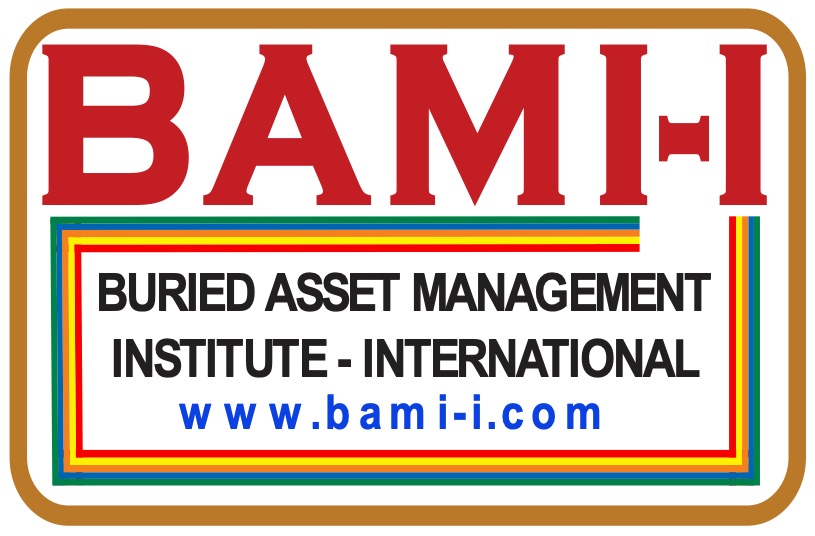February 5, 2024, marked a significant step in our journey toward developing the asset management plan for Switz City, Indiana, as the BAMI-I/Purdue Underground Infrastructure Team (UIT) Team presented phase results to the Town Council of Switz City. The meeting, attended by key council members and our dedicated team, showcased the collaborative efforts invested in this project.
Background
Even though the Indiana Finance Authority (IFA) had published the Guidelines for developing an asset management plan (AMP) for water utilities in 2019, many water utilities, especially the smaller ones, were reluctant to embark on this endeavor for various reasons such as cost, staff requirements and/or just a lack of understanding. This changed with the passage of Indiana Senate Bill (S.B.) 272 which requires water utilities to have an approved AMP by June 30, 2023 to qualify for SRF (State Revolving Fund) loans or grants as well as other funding from State agencies.
Purdue University has a UIT in the CEM (Construction Engineering & Management) program in the College of Engineering. The UIT provides technical and managerial support to BAMI-I (Buried Asset Management Institute-International), a non-profit organization established over 20 years ago in Atlanta’s Department of Watershed Management. Through an EPA Grant BAMI-I has led the way in developing online and classroom AM courses as well as a 2-level certification program to assist water utilities.
As a result of conducting an Asset Management Workshop for the Alliance of Indiana Rural Water Association at their French Lick annual conference, BAMI-I was pleased to learn about the requirements of S.B. 272. This represents national leadership as Indiana joins other States such as Ohio in requiring that water utilities developing AMPs. AMPs provide accountability to funding agencies that the money being provided to water utilities is the right amount of funds being invested in the right projects at the right time.
As a result of conducting AM workshops at the Alliance conference in the Fall of 2022 in Fort Wayne, BAMI-I became acquainted with Ziptility, Inc. It was agreed that we needed to invest our efforts to learn more about developing AMPs utilizing the IFA Guidelines. It was suggested that we start with a small utility, and Switz City was selected. They are less than 300 population but has their own wastewater collection system, treatment plant and drinking water distribution system. They have no employees and utilize the contract services of Ziptility and Bynum Fanyo Utilities (BFU) to handle GIS mapping, data management operations and maintenance. These 3 organizations agreed to volunteer efforts and energy to develop an AMP for Switz City.
This volunteer effort has proven to be an excellent learning experience for the original 3 firms and a few other firms who joined our efforts as well as 22 Civil Engineering and Construction Management Technology graduate students at Purdue University in an Asset Management of Underground Infrastructure (AMUI) course taught by Dr. Tom Iseley. Switz City became the course project as the class was divided into 5 teams with each team required to develop an AMP. Each student went through that BAMI-I CTAM (Certification of Training for Asset Management) course and became certified as AWAM (Associate Water Asset Managers). It is important that we use every opportunity to develop the leaders for our water industry, and they must understand asset management as well as the advanced technology to assist. This includes data acquisition and analysis, location and mapping, as well as technical solutions such as trenchless technologies, etc.
The progress and meetings
During the development of the AMP for Switz City, significant progress was made through a series of strategic meetings and innovative approaches. The project team, comprising experts from BAMI-I, Ziptility, BFU and other key partners, focused on utilizing the IFA guidelines to create a comprehensive risk-based AMP that could serve as a benchmark for other small utilities. These meetings facilitated deep dives into the importance of AMP, adherence to IFA guidelines, and the concept of AMPs as living document crucial for efficient best practices.
It is also noted that conducting onsite manhole inspections and water treatment plant surveys was critical. These activities provided direct insights into the current state and challenges of the city’s water infrastructure, allowing the team to identify specific areas requiring immediate attention and improvement.
The interim asset management plan for Switz City provides a comprehensive assessment and roadmap for improving the city’s water and wastewater infrastructure. It includes a detailed evaluation of the infrastructure’s current state, identifying critical issues like significant water loss through leaks and aging equipment. The plan outlines specific, actionable strategies to address these challenges, emphasizing the importance of updating and maintaining the infrastructure to meet current and future demands. It highlights the need for investment in both physical assets and technology to enhance efficiency, sustainability, and resilience. The AMP also discusses funding mechanisms, suggesting rate adjustments and exploring grants and loans to finance improvements. Key data points include the systems’ estimated replacement value and projected costs for immediate and long-term projects, underscoring the financial implications and benefits of the proposed strategies.



Contributions and Insights
Adam Hershberger, an EPA Water Specialist with the Alliance of Indiana Rural Water, worked closely with the town’s board and utility operators, proposing the development of a comprehensive risk-based AMP to enhance decision-making regarding the utility infrastructure’s maintenance, repair, and replacement. His efforts were instrumental in forming a volunteer group of subject experts to develop the AMP at no cost, overcoming financial barriers. Adam’s initial contributions included assisting with the collection and documentation of asset data, preliminary condition assessments, and updating the town’s GIS platform, laying the groundwork for an informed and strategic approach to asset management in Switz City.
George Kurz made a notable contribution to the project by conducting an in-depth Infiltration and Inflow (I/I) analysis. His work involved using operational data to assess the extent and impact of I/I on Switz City’s wastewater system. Kurz’s analysis provided essential insights into the cost implications of I/I, the potential for sewer rehabilitation, and the payback period of such initiatives. His expertise not only enriched the AMP development process but also offered valuable lessons on managing water assets more effectively.
Jeff Farmer played a significant role in the project, particularly in discussions around utility system diagrams, data management practices, and strategies for reducing energy consumption. His insights were crucial for enhancing the AMP’s focus on operational efficiency and sustainability.
The Purdue UIT Team, led by Dr. Iseley, including Wei Liao and Mahnoush, was overseeing the entire initiative and authoring the final report. Their role entailed coordinating the project’s various components, ensuring adherence to goals and guidelines, and synthesizing the collective efforts and findings into a comprehensive document. Their expertise and guidance were instrumental in driving the project to successful completion, ensuring that the Asset Management Plan was both thorough and actionable.
Educational Activities:
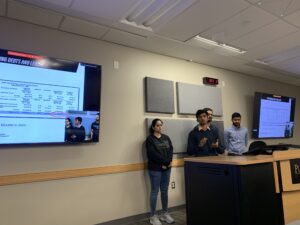
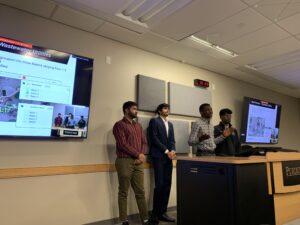
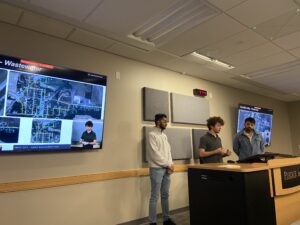
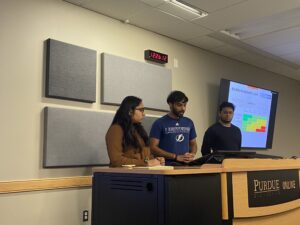


It is important that Purdue UIT Team use every opportunity to develop the leaders for our water industry, and the students must understand asset management as well as the advanced technology to assist. So, this project also included an experiential educational component, where findings and methodologies were shared with Purdue students and professionals through lectures and presentations. This not only contributed to the project’s immediate goals but also helped in building a knowledgeable community around asset management practices. Purdue Asset Management For Underground Infrastructure (AMUI) course taught by Dr. Iseley, is designed for undergraduate juniors, seniors and graduate students interested in critical system management thinking, and who want to be equipped with the knowledge and skills to tackle. The fall 2023 semester featured a series of lectures by key figures, enriching the educational impact.
Significant contributors included:
- Adam Hershberger who spent so much time assisting with meetings, field work and presenting a lecture on the information about the Switz City system in the AMUI course.
- George Kurz shared his knowledge through a lecture for AMUI, further disseminating his findings and reinforcing the project’s educational impact.
- Ross Waugh, Waugh Infrastructure Management Limited, for participating as a keynote speaker in BAMI-I’s Global Buried Asset Management Congress (GBAMC) and presenting a lecture on developing AMPs in the AMUI course.
- Other experts such as Kurt Wright, Gregory Baird, Smith F. Rangel,etc. Gave the lecture on different aspects of asset management in the AMUI course
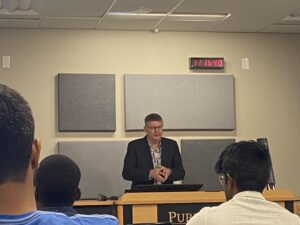
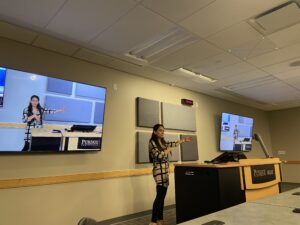
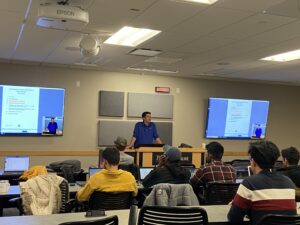
The 22 students in the AMUI course served on 5 teams to develop an AMP for Switz City. Students learned the organizational operation of utilities, developed asset management plans for infrastructure, and enhanced communication skills, preparing them for careers in infrastructure management and improvement.
Next Step
The next steps will focus on seeking funding to address the gaps in actual data support and completing the inventory with accurate information. Based on the recommendation of the interim AMP, the immediate priority is to implement the Near Term (0-5 Year) Capital Improvement Projects, emphasizing completing the Asset Management planning and conducting thorough condition assessments, particularly for pipelines. Acknowledging the challenges in risk-based prioritization due to inadequate asset inventory, enhancing our inventory practices becomes crucial. This involves systematically gathering and updating asset data to ensure a more comprehensive and accurate asset management framework, thereby facilitating informed decision-making and prioritization of maintenance and improvement efforts.
Conclusion
The collaboration on the AMP for Switz City underscores the transformative power of community, expertise, and technology coming together to address complex infrastructure challenges. This initiative not only sets a benchmark for sustainable and efficient asset management but also exemplifies how strategic planning and collaborative efforts can significantly enhance public utilities’ resilience and service delivery. As Switz City moves forward, the lessons learned and successes achieved through this project illuminate a path for other communities to follow, emphasizing the importance of innovation, partnership, and foresight in navigating the future of infrastructure management. At the same time, it’s crucial to recognize the significant gap small, under-resourced communities face in implementing AMPs or infrastructure upgrade projects. This disparity highlights the necessity for government policies to lean towards supporting public utilities in these areas. Ensuring that people have access to safe, high-quality drinking water and clean wastewater disposal is fundamental. Thus, policy adjustments and targeted support are essential to bridge this gap, enabling these communities to manage and upgrade their infrastructure effectively, ensuring public health and environmental standards are met.
